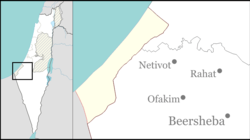Shuva
שׁוּבָה | |
|---|---|
| Coordinates: 31°27′4″N 34°32′42″E / 31.45111°N 34.54500°E | |
| Country | Israel |
| District | Southern |
| Council | Sdot Negev |
| Affiliation | Hapoel HaMizrachi |
| Founded | 1950 |
| Founded by | Libyan Jewish immigrants and refugees |
| Population (2022)
[1] | 744 |
Shuva ( Hebrew: שׁוּבָה) is a religious moshav in southern Israel. Located near Netivot and covering 4,500 dunams, it falls under the jurisdiction of Sdot Negev Regional Council. In 2022 it had a population of 744. [1]
The village was established in 1950 by Jewish immigrants and refugees from Tripoli (in modern Libya). They were later joined by more Jewish immigrants from Algeria and Tunisia. However, this created tensions between the residents, and in 1957 the moshav split in two, with the Tunisian residents leaving to form Zimrat.
Its name was taken from Psalms 126:4;
Turn our captivity, O LORD, as the streams in the dry land.
- ^ a b "Regional Statistics". Israel Central Bureau of Statistics. Retrieved 21 March 2024.
Shuva
שׁוּבָה | |
|---|---|
| Coordinates: 31°27′4″N 34°32′42″E / 31.45111°N 34.54500°E | |
| Country | Israel |
| District | Southern |
| Council | Sdot Negev |
| Affiliation | Hapoel HaMizrachi |
| Founded | 1950 |
| Founded by | Libyan Jewish immigrants and refugees |
| Population (2022)
[1] | 744 |
Shuva ( Hebrew: שׁוּבָה) is a religious moshav in southern Israel. Located near Netivot and covering 4,500 dunams, it falls under the jurisdiction of Sdot Negev Regional Council. In 2022 it had a population of 744. [1]
The village was established in 1950 by Jewish immigrants and refugees from Tripoli (in modern Libya). They were later joined by more Jewish immigrants from Algeria and Tunisia. However, this created tensions between the residents, and in 1957 the moshav split in two, with the Tunisian residents leaving to form Zimrat.
Its name was taken from Psalms 126:4;
Turn our captivity, O LORD, as the streams in the dry land.
- ^ a b "Regional Statistics". Israel Central Bureau of Statistics. Retrieved 21 March 2024.
